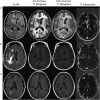Emerging techniques and technologies in brain tumor imaging
- PMID: 25313234
- PMCID: PMC4195527
- DOI: 10.1093/neuonc/nou221
Emerging techniques and technologies in brain tumor imaging
Abstract
The purpose of this report is to describe the state of imaging techniques and technologies for detecting response of brain tumors to treatment in the setting of multicenter clinical trials. Within currently used technologies, implementation of standardized image acquisition and the use of volumetric estimates and subtraction maps are likely to help to improve tumor visualization, delineation, and quantification. Upon further development, refinement, and standardization, imaging technologies such as diffusion and perfusion MRI and amino acid PET may contribute to the detection of tumor response to treatment, particularly in specific treatment settings. Over the next few years, new technologies such as 2(3)Na MRI and CEST imaging technologies will be explored for their use in expanding the ability to quantitatively image tumor response to therapies in a clinical trial setting.
Keywords: MRI; PET; T1 subtraction; brain tumors; diffusion MRI; imaging biomarker; perfusion MRI; response assessment.
© The Author(s) 2014. Published by Oxford University Press on behalf of the Society for Neuro-Oncology. All rights reserved. For permissions, please e-mail: journals.permissions@oup.com.
Figures


Similar articles
-
Impact of imaging measurements on response assessment in glioblastoma clinical trials.Neuro Oncol. 2014 Oct;16 Suppl 7(Suppl 7):vii24-35. doi: 10.1093/neuonc/nou286. Neuro Oncol. 2014. PMID: 25313236 Free PMC article.
-
Report of the Jumpstarting Brain Tumor Drug Development Coalition and FDA clinical trials neuroimaging endpoint workshop (January 30, 2014, Bethesda MD).Neuro Oncol. 2014 Oct;16 Suppl 7(Suppl 7):vii36-47. doi: 10.1093/neuonc/nou226. Neuro Oncol. 2014. PMID: 25313237 Free PMC article.
-
Radiotherapy of high-grade gliomas: current standards and new concepts, innovations in imaging and radiotherapy, and new therapeutic approaches.Chin J Cancer. 2014 Jan;33(1):16-24. doi: 10.5732/cjc.013.10217. Chin J Cancer. 2014. PMID: 24384237 Free PMC article. Review.
-
Biopsy targeting gliomas: do functional imaging techniques identify similar target areas?Invest Radiol. 2010 Dec;45(12):755-68. doi: 10.1097/RLI.0b013e3181ec9db0. Invest Radiol. 2010. PMID: 20829706
-
Current standards and new concepts in MRI and PET response assessment of antiangiogenic therapies in high-grade glioma patients.Neuro Oncol. 2015 Jun;17(6):784-800. doi: 10.1093/neuonc/nou322. Epub 2014 Dec 27. Neuro Oncol. 2015. PMID: 25543124 Free PMC article. Review.
Cited by
-
Volumetric measurements are preferred in the evaluation of mutant IDH inhibition in non-enhancing diffuse gliomas: Evidence from a phase I trial of ivosidenib.Neuro Oncol. 2022 May 4;24(5):770-778. doi: 10.1093/neuonc/noab256. Neuro Oncol. 2022. PMID: 34751786 Free PMC article. Clinical Trial.
-
Prognostic models based on imaging findings in glioblastoma: Human versus Machine.Sci Rep. 2019 Apr 12;9(1):5982. doi: 10.1038/s41598-019-42326-3. Sci Rep. 2019. PMID: 30979965 Free PMC article.
-
Clinical PET/MRI in neurooncology: opportunities and challenges from a single-institution perspective.Clin Transl Imaging. 2017;5(2):135-149. doi: 10.1007/s40336-016-0213-8. Epub 2016 Nov 18. Clin Transl Imaging. 2017. PMID: 28936429 Free PMC article. Review.
-
Morphological MRI-based features provide pretreatment survival prediction in glioblastoma.Eur Radiol. 2019 Apr;29(4):1968-1977. doi: 10.1007/s00330-018-5758-7. Epub 2018 Oct 15. Eur Radiol. 2019. PMID: 30324390
-
Pharmacodynamics of mutant-IDH1 inhibitors in glioma patients probed by in vivo 3D MRS imaging of 2-hydroxyglutarate.Nat Commun. 2018 Apr 16;9(1):1474. doi: 10.1038/s41467-018-03905-6. Nat Commun. 2018. PMID: 29662077 Free PMC article. Clinical Trial.
References
-
- Wintersperger BJ, Runge VM, Biswas J, et al. Brain tumor enhancement in MR imaging at 3 Tesla: comparison of SNR and CNR gain using TSE and GRE techniques. Invest Radiol. 2007;42(8):558–563. - PubMed
-
- Akeson P, Vikhoff B, Stahlberg F, et al. Brain lesion contrast in MR imaging. Dependence on field strength and concentration of gadodiamide injection in patients and phantoms. Acta Radiol. 1997;38(1):14–18. - PubMed
-
- Akeson P, Nordstrom CH, Holtas S. Time-dependency in brain lesion enhancement with gadodiamide injection. Acta Radiol. 1997;38(1):19–24. - PubMed
-
- Vos MJ, Uitdehaag BM, Barkhof F, et al. Interobserver variability in the radiological assessment of response to chemotherapy in glioma. Neurology. 2003;60(5):826–830. - PubMed
MeSH terms
LinkOut - more resources
Full Text Sources
Other Literature Sources
Medical

